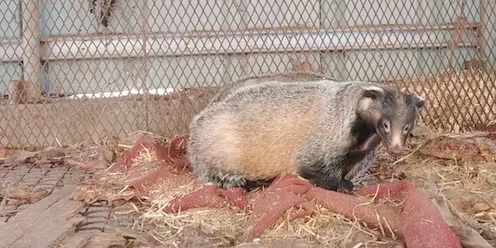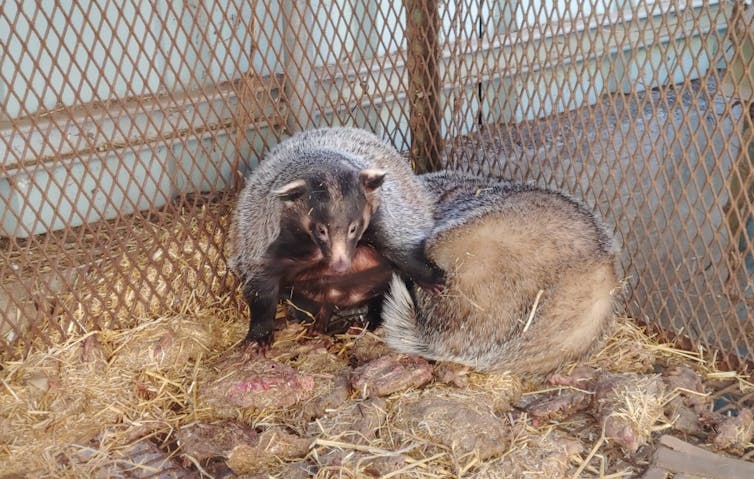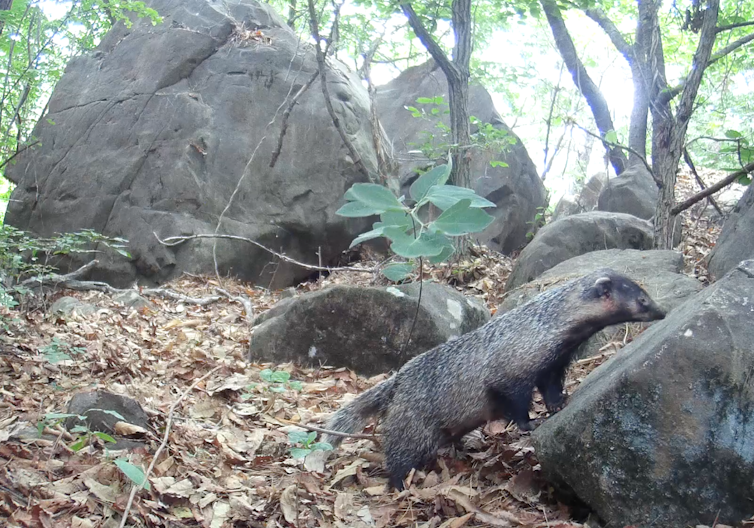Campaigners in South Korea are celebrating news that the country will ban bear farming by 2026. This follows three decades of uncertainty over an industry dogged by claims of poor welfare conditions, animal abuse and illegal breeding.
However, colleagues and I just published the first ever scientific assessment of a form of wildlife farming that, by contrast, has gone completely under the radar: the farming of badgers.
While wildlife trade involving badgers is probably best-known from the fur used in luxury shaving brushes (most of which comes from farms in China), the use and trade of badgers has a surprisingly long – and global – history. For example, apothecaries in medieval France sold badger bones, dried blood, brains, testicles and livers as cures for a range of ailments.
In the 21st century, wildlife market surveys in China, Vietnam, Laos and Indonesia have reported several different species of badger being sold as bushmeat.
Asian badgers, which are closely related to European badgers, have historically been hunted and traded on the Korean Peninsula for their meat or for use in traditional medicine. In the 1990s, however, this trade took a new turn with the emergence of badger farms in South Korea.
This development coincided with increased restrictions on bear bile farming, following the country’s accession to the convention on international trade in endangered species (Cites). Though badger is valued in its own right for traditional medicine, it is also marketed as a potential substitute for bear.
Badgers on an illegal farm in South Korea. Photographer wishes to remain anonymous, Author provided
While there are questions about the reliability of official records of the number of animals on badger farms, the two data sets that are collected annually both agree that in 2019 there were about 4,000 farmed badgers in South Korea, ten times the number of farmed bears.
The number of animals involved has surprised researchers and raises concerns over the welfare of captive badgers, which are highly social and territorial animals. Badgers are difficult to breed in captivity, and very dated advice for badger farmers still published online by the South Korean government includes the use of hormone injections on females to induce breeding.
Badgers famously dig underground setts, so farmers are advised to construct pens with wire or concrete floors to prevent their escape. There is even some evidence of badger cubs being sold as pets, despite their highly unsuitable temperament.
A bear bile farm in South Korea. Badger farming appears to have emerged in part as a substitute for bear farming. Joshua Powell, Author provided
While wild badgers have some legal protection in South Korea, products such as badger gallbladders soaked in liquor, which are sold online, claim to come from either domestic farms or, sometimes, wild animals from Russia or China.
However, we know that badger poaching still occurs in rural South Korea. There would be almost no way for a discerning buyer to distinguish between legal products and those from illegally harvested wild animals.
The trade now also supplies less traditional products. Perhaps the most startling are badger-derived cosmetics, such as soaps, oils and creams which are typically marketed as moisturisers, skin whiteners or as anti-ageing products.
This cream using badger oil, marketed as anti-ageing, whitening and moisturising cream, is available to buy on a well-known Korean online marketplace. misocos.cafe24.com, CC BY-SA
This trade comes with a number of important risks which have so far been almost entirely overlooked, in what can best be summarised as a complete absence of government regulation beyond the collection of basic agricultural records on the number of badgers held by farms.
Farming badgers is a potential biosecurity risk
Researchers have previously warned that wildlife farms could provide the ideal environments for the emergence of future zoonotic diseases.
Camera trap footage of a wild Asian badger in the mountains of South Korea. C.R. Dobson, Author provided
Badgers belong to a family of mammals known as mustelids. Recent outbreaks of zoonotic diseases on mustelid farms, such as the COVID outbreak on a Danish mink farm in 2020 that led to millions of animals being slaughtered, show how this could have implications for both animal and human health.
There are several reasons to be concerned about the transmission of disease (either to animals or humans) on badger farms specifically. The most important is the current lack of sufficient biosecurity protocols, such as checks on the disease status of live animals being sold between farms or to the public, and the hygiene standards required of slaughter facilities.
And there are reports of both wild badgers having been used to stock farms and farmed badgers having been released into the wild, which could facilitate the spread of disease.
From tigers to the giant panda, there can be a tendency for conservation to focus on large, charismatic species. This can sometimes help protect habitat for other species, or draw attention to particular issues.
However, sometimes it can obscure less well-known species and the impacts that we might be having on them. The Asian badger would seem to be one such species.
In South Korea, badger farming appears to present many of the same conservation, welfare and health risks as bear farming does. Unlike bears, badgers have so far been largely overlooked. Hopefully that will now change.



 LA fires: Long-term exposure to wildfire smoke is poorly understood − and a growing risk
LA fires: Long-term exposure to wildfire smoke is poorly understood − and a growing risk  An unexpected anomaly was found in the Pacific Ocean – and it could be a global time marker
An unexpected anomaly was found in the Pacific Ocean – and it could be a global time marker  Ukraine minerals deal: the idea that natural resource extraction can build peace has been around for decades
Ukraine minerals deal: the idea that natural resource extraction can build peace has been around for decades  Drug pollution in water is making salmon take more risks – new research
Drug pollution in water is making salmon take more risks – new research  Fungi are among the planet’s most important organisms — yet they continue to be overlooked in conservation strategies
Fungi are among the planet’s most important organisms — yet they continue to be overlooked in conservation strategies  We combed through old botanical surveys to track how plants on Australia’s islands are changing
We combed through old botanical surveys to track how plants on Australia’s islands are changing  Swimming in the sweet spot: how marine animals save energy on long journeys
Swimming in the sweet spot: how marine animals save energy on long journeys  How is Antarctica melting, exactly? Crucial details are beginning to come into focus
How is Antarctica melting, exactly? Crucial details are beginning to come into focus  How ongoing deforestation is rooted in colonialism and its management practices
How ongoing deforestation is rooted in colonialism and its management practices  Rise of the Zombie Bugs takes readers on a jaw-dropping tour of the parasite world
Rise of the Zombie Bugs takes readers on a jaw-dropping tour of the parasite world  Lake beds are rich environmental records — studying them reveals much about a place’s history
Lake beds are rich environmental records — studying them reveals much about a place’s history 




































